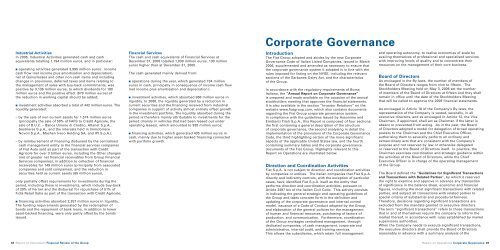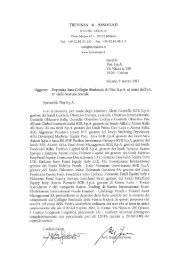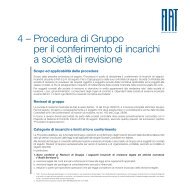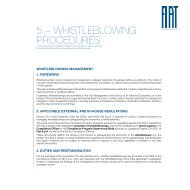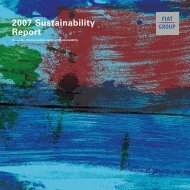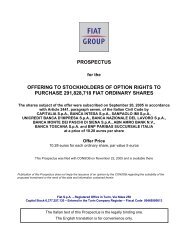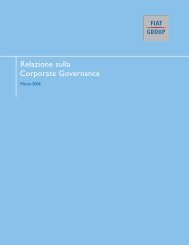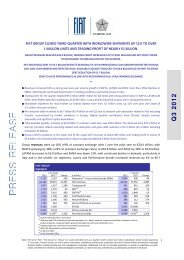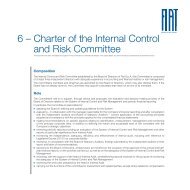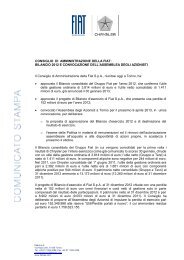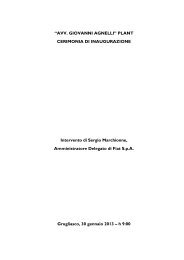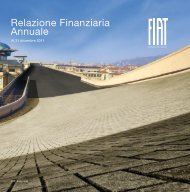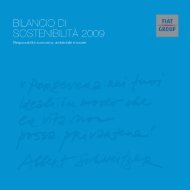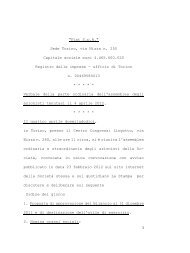2006 Annual Report - Fiat SpA
2006 Annual Report - Fiat SpA
2006 Annual Report - Fiat SpA
Create successful ePaper yourself
Turn your PDF publications into a flip-book with our unique Google optimized e-Paper software.
Industrial Activities<br />
In <strong>2006</strong>, Industrial Activities generated cash and cash<br />
equivalents totalling 1,194 million euros, and in particular:<br />
■ operating activities generated 3,995 million euros: income<br />
cash flow (net income plus amortisation and depreciation),<br />
net of Gains/losses and other non-cash items and including<br />
changes in provisions, deferred taxes and items relating to<br />
the management of sales with buy-back commitments, was<br />
positive by 3,136 million euros, to which dividends for 180<br />
million euros and the positive effect (679 million euros) of<br />
the reduction in working capital should be added;<br />
■ investment activities absorbed a total of 442 million euros. The<br />
liquidity generated:<br />
– by the sale of non-current assets for 1,574 million euros<br />
(principally the sale of 50% of FAFS to Crédit Agricole, the<br />
sale of B.U.C. – Banca Unione di Credito, Atlanet S.p.A.,<br />
Sestrieres S.p.A., and the interests held in Immobiliare<br />
Novoli S.p.A., Machen Iveco Holding SA, and IPI S.p.A.);<br />
– by reimbursement of financing disbursed by the centralised<br />
cash management entity to the financial services companies<br />
of <strong>Fiat</strong> Auto sold as part of the transaction with Crédit<br />
Agricole for over 3 billion euros, including the Other changes<br />
(net of greater net financial receivables from Group Financial<br />
Services companies), in addition to collection of financial<br />
receivables for 149 million euros (principally from associated<br />
companies and sold companies), and the reduction in<br />
securities held as current assets (65 million euros),<br />
only partially offset requirements for investments during the<br />
period, including those in investments, which include buy-back<br />
of 29% of Ferrari and the disbursal for repurchase of 51% of<br />
Fidis Retail Italia as part of the transaction with Crédit Agricole;<br />
■ financing activities absorbed 2,257 million euros in liquidity.<br />
The funding requirements generated by the redemption of<br />
bonds and the repayment of bank loans, in addition to lower<br />
asset-backed financing, were only partly offset by the bonds<br />
issued.<br />
48 <strong>Report</strong> on Operations Financial Review of the Group<br />
Financial Services<br />
The cash and cash equivalents of Financial Services at<br />
December 31, <strong>2006</strong> totalled 1,030 million euros, 130 million<br />
euros higher than at December 31, 2005.<br />
The cash generated mainly derived from:<br />
■ operations during the year, which generated 734 million<br />
euros in cash, principally in consequence of income cash flow<br />
(net income plus amortisation and depreciation);<br />
■ investment activities, which absorbed 968 million euros in<br />
liquidity. In <strong>2006</strong>, the liquidity generated by a reduction in<br />
current securities and the financing received from industrial<br />
companies in support of activity almost entirely offset growth<br />
in the investment portfolio. The liquidity absorbed during the<br />
period is therefore mainly attributable to investments for the<br />
period (mainly in vehicles that had been leased out under<br />
operating leases), which amounted to 935 million euros;<br />
■ financing activities, which generated 435 million euros in<br />
cash, mainly due to higher asset-backed financing connected<br />
with portfolio growth.<br />
Corporate Governance<br />
Introduction<br />
The <strong>Fiat</strong> Group adopted and abides by the new Corporate<br />
Governance Code of Italian Listed Companies, issued in March<br />
<strong>2006</strong>, supplemented and amended as necessary to ensure that<br />
the corporate governance system it adopted is in line with the<br />
rules imposed for listing on the NYSE, including the relevant<br />
sections of the Sarbanes-Oxley Act, and the characteristics<br />
of the Group.<br />
In accordance with the regulatory requirements of Borsa<br />
Italiana, the “<strong>Annual</strong> <strong>Report</strong> on Corporate Governance”<br />
is prepared and made available on the occasion of the annual<br />
stockholders meeting that approves the financial statements.<br />
It is also available in the section “Investor Relations” on the<br />
website www.fiatgroup.com, which also contains documents<br />
regarding the <strong>Fiat</strong> Group corporate governance system.<br />
In compliance with the guidelines issued by Assonime and<br />
Emittenti Titoli S.p.A., this <strong>Report</strong> is composed of four sections:<br />
the first containing a general description of the structure<br />
of corporate governance, the second analysing in detail the<br />
implementation of the provisions of the Corporate Governance<br />
Code, the third highlighting certain of the more significant<br />
aspects of the applicable United States law, and the fourth<br />
containing summary tables and the corporate governance<br />
documents of the <strong>Fiat</strong> Group. Highlights relevant to this<br />
<strong>Report</strong> on Operations are illustrated below.<br />
Direction and Coordination Activities<br />
<strong>Fiat</strong> S.p.A. is not subject to direction and coordination activities<br />
by companies or entities. The Italian companies that <strong>Fiat</strong> S.p.A.<br />
directly and indirectly controls, with the exception of particular<br />
cases, have identified <strong>Fiat</strong> S.p.A. itself as the entity that<br />
performs direction and coordination activities, pursuant to<br />
Article 2497 bis of the Italian Civil Code. This activity consists<br />
in indicating the general strategic and operating guidelines of<br />
the Group and takes concrete form in the definition and<br />
updating of the corporate governance and internal control<br />
model, issuance of a Code of Conduct adopted by the Group,<br />
and elaboration of the general policies for the management<br />
of human and financial resources, purchasing of factors of<br />
production, and communication. Furthermore, coordination<br />
of the Group envisages centralised management, through<br />
dedicated companies, of cash management, corporate and<br />
administrative, internal audit, and training services.<br />
This allows the subsidiaries, which retain full management<br />
and operating autonomy, to realise economies of scale by<br />
availing themselves of professional and specialised services<br />
with improving levels of quality and to concentrate their<br />
resources on the management of their core business.<br />
Board of Directors<br />
As envisaged in the By-laws, the number of members of<br />
the Board of Directors ranges from nine to fifteen. The<br />
Stockholders Meeting held on May 3, <strong>2006</strong> set the number<br />
of members of the Board of Directors at fifteen and they shall<br />
remain in office until the date of the Stockholders Meeting<br />
that will be called to approve the 2008 financial statements.<br />
As envisaged in Article 16 of the Company’s By-laws, the<br />
representation of the Company is vested, severally, in all<br />
executive directors, and as envisaged in Article 12, the Vice<br />
Chairman, if appointed, shall act as Chairman if the latter is<br />
absent or prevented from acting. As in the past, the Board<br />
of Directors adopted a model for delegation of broad operating<br />
powers to the Chairman and the Chief Executive Officer,<br />
authorising them to severally perform all ordinary and<br />
extraordinary acts that are consistent with the Company’s<br />
purpose and not reserved by law or otherwise delegated<br />
or reserved to the Board of Directors itself. In practice, the<br />
Chairman exercises coordination and strategic guidance within<br />
the activities of the Board of Directors, while the Chief<br />
Executive Officer is in charge of the operating management<br />
of the Group.<br />
The Board defined the “Guidelines for Significant Transactions<br />
and Transactions with Related Parties”, by which it reserved<br />
the right to examine and approve in advance any transaction<br />
of significance in the balance sheet, economic and financial<br />
figures, including the most significant transactions with related<br />
parties, and subject all transactions with related parties to<br />
special criteria of substantial and procedural fairness.<br />
Therefore, decisions regarding significant transactions are<br />
excluded from the mandate granted to executive directors.<br />
The term “significant transactions” refers to those transactions<br />
that in and of themselves require the company to inform the<br />
market thereof, in accordance with rules established by market<br />
supervisory authorities.<br />
When the Company needs to execute significant transactions,<br />
the executive directors shall provide the Board of Directors<br />
reasonably in advance with a summary analysis of the<br />
<strong>Report</strong> on Operations Corporate Governance 49


